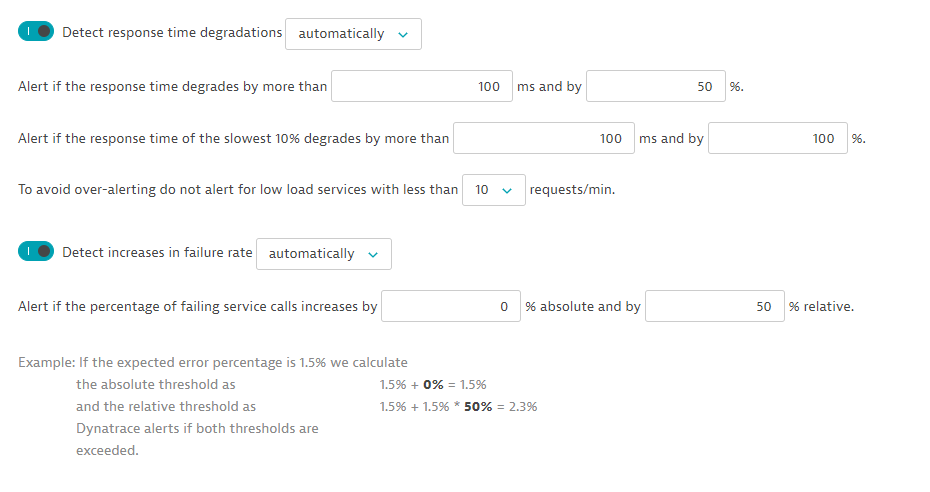Services anomaly detection API - GET configuration
Gets the configuration of anomaly detection for services.
The request produces an application/json payload.
| GET |
|
Parameters
The request doesn't provide any configurable parameters.
Response format
The ServiceAnomalyDetectionConfig object
DESK automatically detects service-related performance anomalies such as response time degradations and failure rate increases. Use these settings to configure detection sensitivity, set alert thresholds, or disable alerting for certain services.
| Element | Type | Description |
|---|---|---|
| metadata | ConfigurationMetadata | Metadata useful for debugging. |
| responseTimeDegradation | ResponseTimeDegradationDetectionConfig | How to detect response time degradation. |
| failureRateIncrease | FailureRateIncreaseDetectionConfig | How to detect failure rate increase. |
The FailureRateIncreaseDetectionConfig object
Configuration of failure rate increase detection.
| Element | Type | Description |
|---|---|---|
| detectionMode | string | How to detect failure rate increase: automatically, or based on fixed thresholds, or do not detect. |
| automaticDetection | FailureRateIncreaseAutodetectionConfig | Parameters of automatic failure rate increase detection. Required if detectionMode is The absolute and relative thresholds both must be exceeded to trigger an alert. Example: If the expected error rate is 1.5%, and you set an absolute increase of 1%, and you set a relative increase of 50%, the thresholds will be: Absolute: 1.5% + 1% = 2.5% Relative: 1.5% + 1.5% * 50% = 2.25% |
| thresholds | FailureRateIncreaseThresholdConfig | Fixed thresholds for failure rate increase detection. Required if the detectionMode is |
The FailureRateIncreaseThresholdConfig object
Fixed thresholds for failure rate increase detection.
Required if detectionMode is DETECT_USING_FIXED_THRESHOLDS. Not applicable otherwise.
| Element | Type | Description |
|---|---|---|
| threshold | integer | Failure rate during any 5-minute period to trigger an alert, %. |
| sensitivity | string | Sensitivity of the threshold. With With |
The FailureRateIncreaseAutodetectionConfig object
Parameters of failure rate increase auto-detection. Required if detectionMode is DETECT_AUTOMATICALLY. Not applicable otherwise.
The absolute and relative thresholds both must exceed to trigger an alert.
Example: If the expected error rate is 1.5%, and you set an absolute increase of 1%, and a relative increase of 50%, the thresholds will be: Absolute: 1.5% + 1% = 2.5% Relative: 1.5% + 1.5% * 50% = 2.25%
| Element | Type | Description |
|---|---|---|
| failingServiceCallPercentageIncreaseAbsolute | integer | Absolute increase of failing service calls to trigger an alert, %. |
| failingServiceCallPercentageIncreaseRelative | integer | Relative increase of failing service calls to trigger an alert, %. |
The ResponseTimeDegradationDetectionConfig object
Configuration of response time degradation detection.
| Element | Type | Description |
|---|---|---|
| detectionMode | string | How to detect response time degradation: automatically, or based on fixed thresholds, or do not detect. |
| automaticDetection | ResponseTimeDegradationAutodetectionConfig | Parameters of automatic response time degradation detection. Required if detectionMode is Violation of any criterion triggers an alert. |
| thresholds | ResponseTimeDegradationThresholdConfig | Fixed thresholds for response time degradation detection. Required if detectionMode is |
The ResponseTimeDegradationThresholdConfig object
Fixed thresholds for response time degradation detection.
Required if detectionMode is DETECT_USING_FIXED_THRESHOLDS. Not applicable otherwise.
| Element | Type | Description |
|---|---|---|
| responseTimeThresholdMilliseconds | integer | Response time during any 5-minute period to trigger an alert, in milliseconds. |
| slowestResponseTimeThresholdMilliseconds | integer | Response time of the 10% slowest during any 5-minute period to trigger an alert, in milliseconds. |
| loadThreshold | string | Minimal service load to detect response time degradation. Response time degradation of services with smaller load won't trigger alerts. |
| sensitivity | string | Sensitivity of the threshold. With With |
The ResponseTimeDegradationAutodetectionConfig object
Parameters of the response time degradation auto-detection. Required if the detectionMode is DETECT_AUTOMATICALLY. Not applicable otherwise.
Violation of any criterion triggers an alert.
| Element | Type | Description |
|---|---|---|
| responseTimeDegradationMilliseconds | integer | Alert if the response time degrades by more than X milliseconds. |
| responseTimeDegradationPercent | integer | Alert if the response time degrades by more than X %. |
| slowestResponseTimeDegradationMilliseconds | integer | Alert if the response time of the slowest 10% degrades by more than X milliseconds. |
| slowestResponseTimeDegradationPercent | integer | Alert if the response time of the slowest 10% degrades by more than X %. |
| loadThreshold | string | Minimal service load to detect response time degradation. Response time degradation of services with smaller load won't trigger alerts. |
The ConfigurationMetadata object
Metadata useful for debugging
| Element | Type | Description |
|---|---|---|
| configurationVersions | integer[] | A Sorted list of the version numbers of the configuration. |
| clusterVersion | string | DESK server version. |
{
"metadata": {
"configurationVersions": [
4,
2
],
"clusterVersion": {
"major": 0,
"minor": 0,
"revision": 0,
"sourceRevision": "",
"timestamp": ""
}
},
"responseTimeDegradation": {
"detectionMode": "DETECT_AUTOMATICALLY",
"automaticDetection": {
"responseTimeDegradationMilliseconds": 250,
"responseTimeDegradationPercent": 90,
"slowestResponseTimeDegradationMilliseconds": 500,
"slowestResponseTimeDegradationPercent": 200,
"loadThreshold": "ONE_REQUEST_PER_MINUTE"
}
},
"failureRateIncrease": {
"detectionMode": "DETECT_USING_FIXED_THRESHOLDS",
"thresholds": {
"threshold": 10,
"sensitivity": "LOW"
}
}
}
Example
In this example, the request lists the current configuration of anomaly detection for services.
The API token is passed in the Authorization header.
The configuration has the following settings:

Curl
curl -X GET \
https://mySampleEnv.live.dexp.ae/api/config/v1/anomalyDetection/services \
-H 'Authorization: Api-token abcdefjhij1234567890'
Request URL
https://mySampleEnv.live.dexp.ae/api/config/v1/anomalyDetection/services
Response body
{
"metadata": {
"clusterVersion": "1.163.14.20190204-102159",
"configurationVersions": [
2
]
},
"responseTimeDegradation": {
"detectionMode": "DETECT_AUTOMATICALLY",
"automaticDetection": {
"responseTimeDegradationMilliseconds": 100,
"responseTimeDegradationPercent": 50,
"slowestResponseTimeDegradationMilliseconds": 100,
"slowestResponseTimeDegradationPercent": 100,
"loadThreshold": "TEN_REQUESTS_PER_MINUTE"
}
},
"failureRateIncrease": {
"detectionMode": "DETECT_AUTOMATICALLY",
"automaticDetection": {
"failingServiceCallPercentageIncreaseAbsolute": 0,
"failingServiceCallPercentageIncreaseRelative": 50
}
}
}
Response code
200